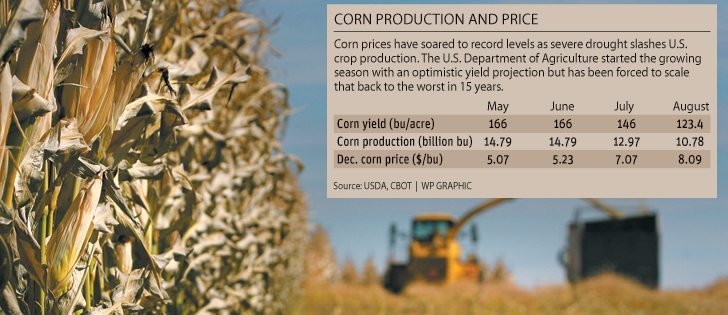Drought devastates corn | Prices are already high in Canada so the United States may look to other countries for feed crops
The gaping hole that the Midwest drought has left in U.S. corn production creates a vacuum that could draw in lots of wheat and other cereal feedgrains.
However, it’s hard to tell whether the vacuum will pull Canadian wheat, barley and oats south to the U.S. or if it will simply keep the prices of those prairie feedgrains firm as supplies are found further away.
“I think U.S. Department of Agriculture has underestimated the amount of non-corn cereal grains that will be used to replace U.S. corn,” said LeftField Commodity Research analyst Chuck Penner shortly after the crucial USDA supply and demand reports were released Aug. 10.
Read Also

Flax sector sees omega-3 opportunity
SASKATOON — A global shortage of omega-3 oils could be an opportunity for the flax sector, says an industry official….
“They really haven’t ramped up the feed use of wheat enough.”
The USDA confirmed what everyone knew about U.S. corn production — drought has devastated the crop.
USDA dropped its estimate of average yields to 123.4 bushels per acre from the 146 bu. per acre estimated in July, which was already a big drop from the 166 bu. per acre estimated at the start of the season.
Most analysts already expect the final yield to be less than 123 bu. per acre.
Total corn production was lowered to 10.8 billion bu. and by the end of 2012-13 the supply will fall to 650 million bu., only a three-week supply of the grain used for feeding livestock, producing ethanol and for exports.
The yield numbers and the production side of the supply and demand equation are easier to estimate than the consumption side, so it was the consumption side of the USDA analysis that most private analysts were watching.
The USDA reduced U.S. feedgrain corn use by 725 million bu., cut ethanol use by 400 million bu. and shrank exports by 300 million bu. to leave a 5.8 percent ending-stocks-to-use for 2012-13.
That amount of feed demand destruction for corn will be hard to achieve, said Darin Newsom of DTN, which is why commercial users are still scrambling to buy physical supplies of corn.
The Chicago corn futures market shows inverses between nearby months and contracts later in the crop year. That is evidence corn users are trying to cover their commitments and don’t want to leave buying until later in the year.
Corn demand is known as elastic, which is an economics term that means demand can be reduced or increased if prices change. It is the world’s primary feedgrain, but most of its uses can be supplied by other feedgrains such as wheat, oats and barley.
The world has lots of wheat, but stockpiles continue to fall and the trend will likely continue with the impact of the drought and weather problems overseas, as well as wheat being substituted for corn in feed rations.
USDA pegged world wheat production at 662.8 million tonnes, down from 665.3 million last month and 695.2 million last year.
Year end stocks were lowered to 177.2 million tonnes, down from 182.4 million last month and 197.6 million last year.
“This thing continues to come down,” said Newsom about wheat supplies.
North American oats are much tighter and have enjoyed the rally as well. As a result, Randy Strychar of Ag Commodity Research expects oats demand and prices to be strong this crop year.
“USDA numbers confirm outlook for strong grain prices, including oats,” Strychar wrote as the headline for his weekly oat market report. He estimated that oat prices will trade in a $3.70 to $4.70 range, which is higher than the recent range. He expects prices of oats to be relatively stronger than for most crops over the winter, but it is hard to say if a rally will begin from today’s prices or from lower harvest-affected prices.
Penner thinks American buyers will need to import crops such as barley and oats, but they might not get them from Canada.
“They’re going to have a tough time getting them from us,” said Penner.
“We don’t have a lot of oats and barley to be increasing our exports.”
Barley prices are already sky-high in Alberta, and farmers and grain companies don’t need to ship feedgrains out of Western Canada to get good prices.
Penner said Argentine barley might flow into the United States.
However, the impact on relative cereal grain prices will be good, regardless of where wheat, barley and oats are found to fill in the corn production hole.
















